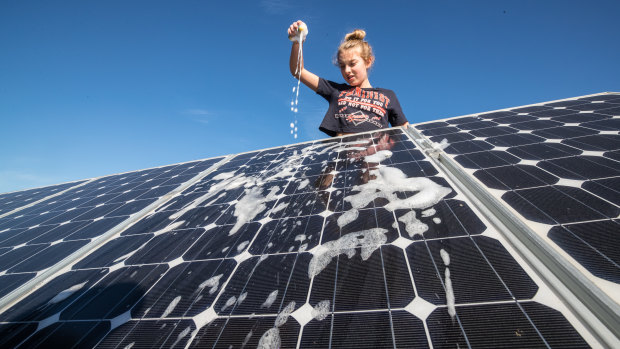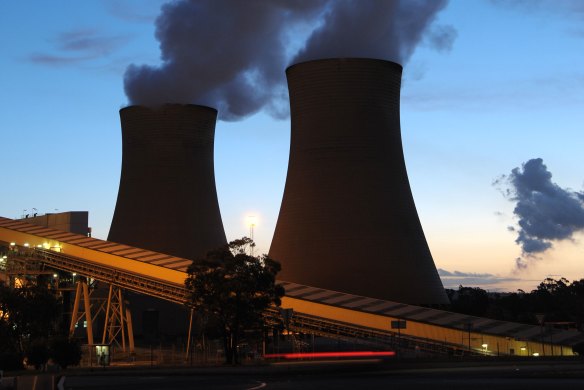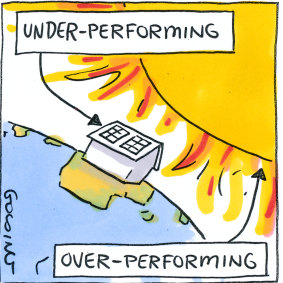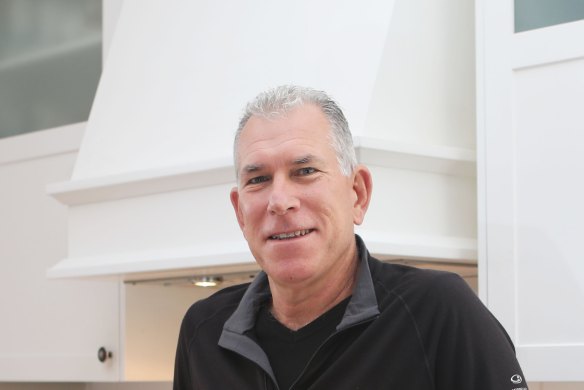- Exclusive
- Politics
- Federal
- Renewables
This was published 5 years ago
One in five rooftop solar units deficient, official figures show
By Nicole Hasham
One in five rooftop solar systems are deficient and thousands of Australians are being denied lower power bills because their household solar delivers less electricity than promised, new data shows.
As the number of rooftop solar systems on Australian homes and businesses tops 1.8 million, there are calls for stronger safeguards to weed out dodgy operators and ensure the technology’s benefits are fully realised.

The Clean Energy Regulator found one in five rooftop solar systems were substandard.Credit: Jason South
The Clean Energy Council, which accredits 5000 solar installers in Australia, cancelled 13 accreditations this financial year and temporarily suspended 153 installers.
NSW Fair Trading has received 3327 complaints about the photovoltaic industry over the past five years, while Consumer Affairs Victoria received 6436 in the four years to June last year.
As well as reducing greenhouse gas emissions, rooftop solar can slash electricity bills and generate money by feeding electricity back into the grid.
As of the end of April, the installed capacity of small-scale solar in Australia was 6859 megawatts - enough to power every home in Sydney. It mostly comprises rooftop systems. The uptake is the highest per capita in the world, and by 2035 is forecast to potentially exceed 20,000 megawatts.

Rooftop solar reduces reliance on fossil fuels such as coal.Credit: Photographer: Carla Gottgens/Bloomberg
The Australian Energy Market Operator says rooftop solar and battery storage has the potential to improve the reliability of supply and reduce demand at peak times, and industry research found it can lower wholesale electricity prices.
However unpublished data by the Clean Energy Regulator, obtained by Fairfax Media, suggests the technology may not always deliver as promised.
Of 4140 small-scale solar systems, mostly rooftop units, inspected last year, 822 were “substandard”, meaning they did not meet Australian requirements and may prematurely fail. This equates to almost 20 per cent, compared to 22 per cent the previous year.

Illustration: Matt Golding
Common problems included installers not using heavy-duty plastic coating to protect wiring, and components being incorrectly mounted or installed. Not all such issues would affect electricity yield.
About 2 per cent of systems were deemed unsafe, often because water had entered electrical components.
University of NSW research published in late 2016 showed the performance of rooftop solar systems in Australia varies widely.
In Sydney, the worst-performing 25 per cent of systems had electricity yields at least 16 per cent lower than the best-performing 25 per cent of systems. In Melbourne and Brisbane the difference was 13 per cent.
Senior lecturer at the university’s School of Photovoltaic and Renewable Energy Engineering, Anna Bruce, said most rooftop systems performed as expected.
However some were “not performing well at all” and in many cases, the owners were oblivious.
“Those households are not getting their money back to cover the cost of that investment,” Dr Bruce said.
“They could be saving a lot more money off their electricity bills and we could be reducing more emissions if those systems were performing properly.
“We need to be watching and making sure [the systems] are properly maintained,” she said, adding “there will be failures” as systems installed over the past decade began to age.
Pieter Lindhout, from Annandale in Sydney’s inner west, installed solar panels on his family home about six years ago. After purchasing a monitoring device to track energy production and consumption, it showed “no electricity being produced”.

Pieter Lindhout was shocked to realise his rooftop solar was not producing any electricity.Credit: Daniel Munoz
“That was a shock,” he said, estimating the system had been dormant for up to four months.
Mr Lindhout replaced a broken inverter, which converts the solar system current into one that can be used by home appliances.
But another issue soon emerged - cables into the solar panels were touching the roof, and the panels short circuited when it rained.
Without monitoring “I would not have been aware that my system was working at 60 per cent,” Mr Lindhout said.
Clean Energy Council chief executive Kane Thornton said solar power systems should be regularly maintained.
“While most systems are performing as they should, there will be some systems which are underperforming,” he said.
Only a tiny proportion of solar households monitor the system’s performance. Solar Analytics chief executive Stefan Jarnason, whose organisation is the nation’s largest independent energy monitoring provider, said while installers were generally “very good these days, there’s always some shonky ones around, as there are in any industry.”
The company's analysis of data from over 6000 photovoltaic sites that are not actively monitored found 11 per cent were likely to be generating less than half their expected output.
Sustainability consultant Michael Mobbs, of the inner Sydney suburb of Chippendale, has suffered a string of design and installation problems with his $26,000 rooftop solar and storage system installed in 2015. Monitoring revealed the system was providing just 46 per cent the promised electricity.
Mr Mobbs said his clients frequently reported underperforming rooftop solar, and the industry should be more strictly audited and accredited, while data monitoring should be mandatory.